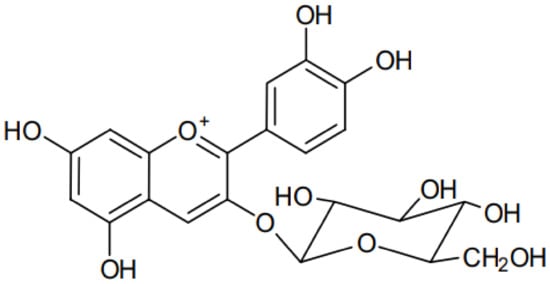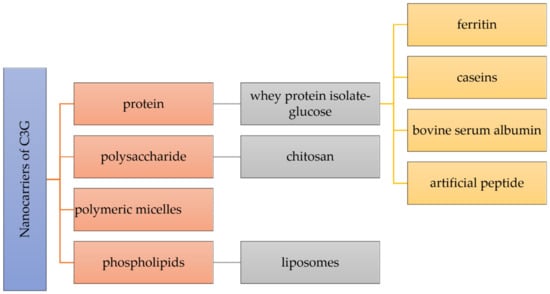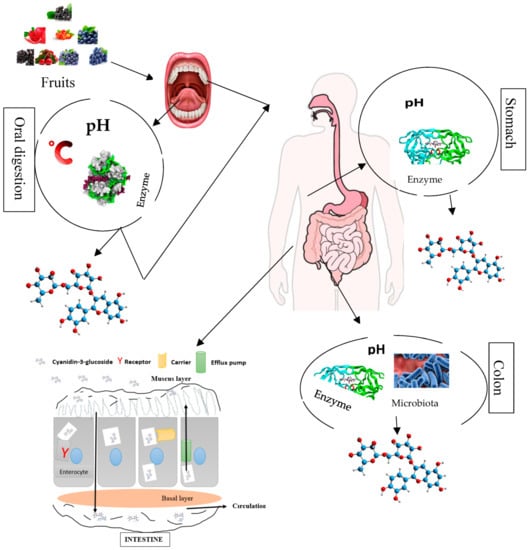You're using an outdated browser. Please upgrade to a modern browser for the best experience.
Please note this is a comparison between Version 1 by Charalampos Proestos and Version 2 by Lindsay Dong.
Cyanidin 3-O-glucoside (C3G) is a secondary metabolite naturally present in plants. It is a water-soluble bioactive compound belonging to the class of monomeric anthocyanin, one of the main classes of the flavonoid family. TRecently, there has been considerable interest in work on anthocyanin derivatives. There are two main reasons for this increased interest: (i) anthocyanin derivatives are important sources of natural pigments primarily used as food colorants, (ii) and their regular consumption has significant health benefits.
- cyanidin 3-O-glucoside
- extraction
- nanoencapsulation
1. Chemical Structure and Health Properties of Cyanidin 3-O-Glucoside
Cyanidin 3-O-glucoside (C3G) (Figure 1) is an anthocyanin compound derived from the aglycone cyanidin. It is a red pigment of anthocyanin commonly and naturally found in vegetables and fruits. C3G is highly hydrophilic, with a solubility of 0.6 mg/mL, LogP of 0.39, Å2 of 193.4, [M]+ (m/z) of 449, and MS/MS (m/z) of 287 [1][12].

Figure 1.
Chemical structure of cyanidin 3-
O
-glucoside.
The UV-vis spectrum of C3G at different pH (pH 3–8) revealed that C3G is pH-dependent [2][13]. In this case, it was found that the flavylium cation absorbance is dominant at pH 3, whose intensity decreases at pH 4–5, but at pH 5, the quinoidal species starts dominating. At pH 6–8, cyandin-3-glucoside takes the quinoidal and chalcone forms.
C3G is a well-known natural anthocyanin and possesses tremendous health benefits. Wang et al. [3][14] studied the ability of C3G and its phenolic acid metabolites to attenuate the visible light-induced retinal degeneration and found out that the C3G, protocatechuic acid, and ferulic acid caused a higher secretion and expression of heme oxygenase (HO-1) and nuclear factor erythroid-2-related factor 2 (Nrf2), indicating the attenuation of the secretion or expression of inflammation-related genes. Likewise, the treatments attenuated the photo-oxidation-induced apoptosis and angiogenesis in the retina. Du et al. [4][15] reported that the C3G as well as cyanidin chloride hinder the accumulation of cholesterol and inhibit the LXRα pathway-induced inflammatory response. In the study of Chen et al. [5][16], it was found that the C3G and peonidin 3-glucoside exhibited anticancer activity via G2/M arrest with peonidin 3-glucoside treatment, showing downregulation of protein levels of cyclin-dependent kinase (CDK)-1, CDK-2, cyclin B1, and cyclin E, while cyanidin 3-O-glucoside reduced the protein levels of CDK-1, CDK-2, cyclin B1, and cyclin D1. The potency of C3G to improve the hyperglycemia and insulin sensitivity in diabetic mice fed with dietary C3G for 5 weeks was investigated [6][17].
2. Extraction of Cyanidin 3-O-Glucoside
The recovery of anthocyanins is affected by the extraction techniques and extraction conditions, such as temperature, type of solvents, solvent ratio, and extraction time [7][8][24,25]. The influence of extraction techniques, type of solvents. Conventional techniques such as Soxhlet extraction and maceration are widely used for extraction of phenolic compounds such as C3G. For example, Santos et al. [9][26] successfully applied the Soxhlet extraction to recover C3G from Jabuticaba (Myrciaria cauliflora) skins. Likewise, Ćujić et al. [10][27] and Meregalli et al. [11][28] determined that the maceration extraction can be used to extract the C3G from various plant materials. Nonetheless, considering these studies on the extraction of C3G by conventional techniques, it can be evidenced that they are time-consuming and mainly depend on the type of solvent. The emerging extraction technologies proved to be more efficient regarding the extraction yield of C3G. A comparative study implying ultrasound-assisted extraction, agitated bed extraction, combined ultrasound-assisted extraction + agitated bed extraction, and Soxhlet extraction has been carried out for the extraction of C3G, and the results showed that the use of shorter ultrasonic irradiation is viable and increased the extraction performance [9][26]. Although the use of ultrasound-assisted extraction can imply high energy consumption, it is more efficient, rapid, and selective regarding the extraction of anthocyanin than the conventional extraction techniques such as agitated bed extraction, maceration, and Soxhlet extraction [12][13][29,30]. Microwave-assisted extraction, which uses the energy of microwaves to induce the molecular movement and rotation of liquids with a permanent dipole, is also an emerging extraction technology for the recovery of C3G [14][31]. The implementation of microwave-assisted extraction causes, through the energy of microwaves, a rapid heating of the solvent and the sample, leading to the release of bioactive compounds. Microwave-assisted extraction has been found highly efficient for the extraction of anthocyanin derivatives such as C3G, pelargonidin 3-glucoside, and peonidin 3-glucoside from purple corn when compared to the conventional extraction procedure [15][32]. Ohmic heating technology is also based on the application of electric fields, and use of its thermal nature allows for a controllable heating rate, unrestricted treatment time scale, unrestricted type of waveform and frequency, and the presence of alternating moderate to low electric fields [16][34]. It is generally used as a pre-treatment prior to the extraction to increase the efficiency of the extraction technique. The grape skins have been pre-treated by ohmic heating, followed by aqueous extraction under a gentle orbital shaking system [16][34]. It resulted that ohmic heating allowed to boost extraction levels of total phenolic compounds, delphinidin 3-O-glucoside, C3G, petunidin 3-glucoside, peonidin 3-O-glucoside-3-glucoside, and malvidin 3-O-glucoside, as well as the conductivity, soluble solids, and red color intensity of the obtained extracts. The application of ohmic heating allows not only the increase of extraction yield but also reduces the extraction time [17][35]. High hydrostatic pressure is a cold pasteurization method used as a good alternative to heat-based treatments, consisting of subjecting samples to pressures up to 1000 MPa inside a vessel filled mainly with water, acting as a pressure-transmitting medium. During the high hydrostatic pressure processing, the pressure is transferred into the sample in an isostatic and quasi-instantaneous manner [18][36]. Recently, a comparative study of ultrasound-assisted, microwave-assisted, high hydrostatic pressure, and conventional extraction methods has been conducted for the extraction of C3G, and the results showed that the high hydrostatic pressure extraction technique can be used for the recovery of C3G, although ultrasound- and microwave-assisted extractions are more efficient [18][36]. Supercritical CO2 extraction uses carbon dioxide above its critical point and exhibits liquid- and gas-like proprieties. Supercritical and subcritical CO2 extractions have been commonly used to improve the extraction and selectivity of plant bioactive compounds. Babova et al. [19][38] applied the supercritical and subcritical CO2 extractions to maximize the recovery of anthocyanin from bilberry. These techniques have selectively and highly extracted C3G, as well as cyanidin 3-O-arabinoside, delphinidin 3-O-glucoside, ellagic acid pentoside, feruloyl hexoside, and quercetin glycosides. Moreover, the use of co-solvents such as water and ethanol in the supercritical CO2 extraction increases the recovery C3G [20][39]. Pressurized fluid extraction is a nonthermal technique that exposes the fluid to pressures above 6 bar and temperatures above 100 °C in the case of water [21][40].3. Different Nanocarriers of Cyanidin 3-O-Glucoside
The stability, controlled release, intestinal absorption, and bioavailability of nutraceuticals can be improved by a key strategy depending on the creation of nanocarriers. As preferable carrying materials, proteins, polysaccharides, and phospholipids obtained from food are biocompatible, biodegradable, and “generally recognized as safe” (Figure 2) [22][6].
Figure 2.
Different nanocarriers used for the encapsulation of cyanidin 3-
O
-glucoside.
Many types of nanocarriers have been utilized for the delivery of C3G, including whey protein isolate-glucose (WPI-Glu) nanoparticles, which demonstrated a unique protein delivery method that provides high stability of C3G in acidic and high-temperature conditions [23][43]. C3G molecules were encapsulated within a ferritin nanocage in order to increase their stability [24][44]. By encapsulating nanotechnology, protein cage designs such as ferritins provide a strong potential to increase the stability of C3G. The first protein with a shell-like structure employed for the creation of nanomaterials is ferritin, which is a particular kind of widely distributed iron-storage protein [24][44]. The molecule ferritin, which has a molecular mass of about 500 kDa and external and internal diameters of 12 and 8 nm, is made up of 24 subunits that self-assemble into a shell-like structure with 432 symmetries. Ferritin is used to oxidize and store iron as microcrystalline, hydrated ferric oxide particles. The protein shell of ferritin has a remarkable resistance to chemical and physical denaturants, and the reassembly technique might be utilized to encapsulate such unstable small species, such as C3G, that could not enter the protein cavity through the subunit junction pores [24][44]. Therefore, C3G was encapsulated in a ferritin nanocage using the reassembling ability of ferritin. It was discovered that such encapsulation significantly improved anthocyanin stability while facilitating C3G transport through Caco-2 cell monolayers [24][44].
Chitosan has attracted a lot of attention for the encapsulation and delivery of bioactive substances because of its exceptional functionality. However, in the latest mentioned study, in order to increase the stability of C3G, chitosan, chitosan oligosaccharides, and carboxymethyl chitosan were combined with ionic crosslinking agents γ-polyglutamic acid nanoparticles [25][49]. Similarly, Ge et al. generated new nanocomplexes in their work to stabilize C3G utilizing the chitosan derivatives chitosan hydrochloride (CHC) and carboxymethyl chitosan (CMC). These two distinct water-soluble chitosan derivatives, which have significant surface positive and negative charges, respectively, are able to increase the stability of C3G via intermolecular electrostatic interactions [26][27][52,53]. Chitosan is a linear cationic polysaccharide composed of β-(1–4)-linked D-glucosamine and N-acetyl-D-glucose-amine, obtained by the deacetylation of crustacean chitin. Chitosan is a non-toxic, biodegradable, biocompatible, film-forming, antioxidant, and antibacterial natural biopolymer that is second in abundance after cellulose in terms of natural biopolymers [26][28][11,52]. Moreover, the effects of C3G alone and encapsulated in chitosan nanoparticles (Nano-C3G) in a UVB-induced acute 4 photodamage animal model were assessed in another study for the encapsulation of C3G within chitosan [29][54].

4. Nanoencapsulation Techniques of Cyanidin 3-O-Glucoside
4.1. Spray-Drying Encapsulation of Cyanidin 3-O-Glucoside
Spray-drying is considered one of the oldest and most popular processes used for the nano/encapsulation of anthocyanin’s components, including C3G, found in fruits and vegetables [30][70]. The data of encapsulation methods collected by some researchers showed that 31.37% of investigations were based on the spray-drying technique [31][69]. When compared to other encapsulation processes, spray-drying is known as an effective low-cost method, capable to obtain superior-quality dry particles using largely accessible equipment [32][67]. This process can be used to generate anthocyanin powder loaded with C3G with increased storage stability and favors a faster production and better control over the particle size dispersion [33][71]. The choice of barrier materials is fundamentally the most important step in this process, where some factors should be considered for strong protection of the core material based on its physicochemical properties [32][67]. For an effective bioactive compound protection, the spray-drying process is generally combined with biopolymer agents such as maltodextrin, cyclodextrin, gums, modified starch, lipids, and protein nanoparticles. Inulin and sodium alginate combined with spray-drying in the encapsulation of maqui juice showed encapsulation performances of 68.6 and 47.3%, respectively.4.2. Freeze-Drying Encapsulation of Cyanidin 3-O-Glucoside
Anthocyanin derivatives comprising C3G are very sensitive to high-temperature and heat treatments, and thus spray-drying application is sometime detrimental to anthocyanin components. Freeze-drying is regarded as one of the best drying candidates for anthocyanin, and especially for C3G encapsulation. This drying process offers the dehydration of frozen sample mixtures of core and nano/micro-carrier agents via sublimation under vacuum and reduced temperature, resulting in great chemical structure preservation and a well-reduced risk of unwanted changes in dried samples [34][75]. Thanks to the low operating temperature, it is a suitable method for anthocyanin and related phenolic components’ encapsulation as they are thermosensitive materials. This process yields high-quality products with acceptable sensory properties, preserves the bio-accessibility and functionality, extends the shelf-life for bioactive compounds, and improves the thermal and color stability of anthocyanin components through diverse carrier agents [35][36][76,77].4.3. Lipid-Based Encapsulation of Cyanidin 3-O-Glucoside
Among the nano/encapsulation methods, lipid-based micro/nanocarrier techniques are also one of the most applied processes for anthocyanin derivatives’ encapsulation. Two classes of lipid-based nanoencapsulation techniques can be distinguished. Emulsions, fabricated with oil, water, and surfactants in various forms. These emulsions can be formulated using a single oil in water (O/W), or vice versa (W/O), double-oil in water (O/W/O), or water in oil in water (W/O/W) emulsions [37][63]. These emulsions, including Pickering emulsions, are promising lipid-based encapsulation processes for food and related industries as anthocyanin-encompassing C3G distribution systems. The emulsion droplets used to trap these bioactive compounds may be obtained in a large variety of food-grade constituents, such as polysaccharides and proteins. Recent studies on emulsions’ encapsulation indicated that 5 out of 51 cases, covering 10%, focused on establishing water in oil in water (W/O/W) emulsions for encapsulating anthocyanin derivatives. Several agents, such as guar gum and whey protein, have been reported in producing W/O/W emulsions for encapsulating anthocyanin, including C3G, in plant-based food [31][69]. The results of Bamba et al. [38][82] revealed that increasing the time of water/oil emulsion from 5 to 10 min at 10,000 rpm ensured a higher anthocyanin encapsulation performance by decreasing the droplets’ dimeter.4.4. Biopolymer-Based Encapsulation of Cyanidin 3-O-Glucoside
Another widely use encapsulation technique is the ionic gelation process, which is a part of a biopolymer-based encapsulation method to fabricate micro/nanocarriers to encapsulate C3G and associated anthocyanin derivatives. Ionic nano/microgels could be developed via a combination of two distinct surface-charged biopolymers [39][40][87,88]. Biopolymer nano/microcarriers have been produced by a specific biopolymer, such as carbohydrates (chitosan, maltodextrin, β-cyclodextrin, alginates, and starch, etc.), proteins (whey and soy proteins, etc.), and plant-based hydrophilic gums [41][42][89,90]. Mar et al. [43][91] reported that among the nano/microgels used to encapsulate anthocyanin constituents, including C3G, alginate hydrogel beads and samples coated with chitosan were more effective in encapsulating and preserving the anthocyanin. They observed higher antioxidant potential with alginate hydrogel compared to samples with whey protein concentrate and gelatine.4.5. Electrohydrodynamic Encapsulation of Cyanidin 3-O-Glucoside
This encapsulation process composed of electrospinning and electro-spraying is regarded as an alternative technique to conventional ones. For instance, the electrohydrodynamic process has been newly proposed as a beneficial, cost-effective, simple, and flexible technique for fabricating encapsulation materials for different bioactive constituents such as anthocyanin, mainly C3G [44][45][46][66,94,95]. This process is especially advantageous for the encapsulation and preservation of thermo/photosensitive molecules such as cyanidin 3-O-glucoside and other anthocyanin components. Different electrohydrodynamic production processes which are able to generate encapsulation barriers in one step, with low temperature, nontoxic reagents, and lower interaction with bioactive components, yielding high loading efficiencies, have been reported in previous studies [47][96]. The electrospinning and electro-spraying techniques are almost similar in functionality and apparatus design, and the main differences between these two processes are the final products generated, namely nanodroplets for the electro-spraying process and nanofibers for the electrospinning method. The distinction of the nanofibers and nanodroplets obtained is evaluated by the intrinsic viscosity of the solution and biomaterials’ concentration [44][66].5. Bioavailability and Bio-Accessibility of Cyanidin 3-O-Glucoside
The bio-accessibility of anthocyanin components comprising C3G through the different compartments of the digestive tract firstly start from their release from the food matrix. C3G and other anthocyanin components after liberation enter in contact with some micro-molecules, enzymes, and other phenolic compounds, which might affect their bio-accessibility [48][49][50][51][52][99,100,101,102,103]. Anthocyanin components including C3G have frequently been reported to poorly assimilate in the different compartments of the digestive tract or gastrointestinal track, and they have a low diffusion rate, which limits their application in functional food (foods with physiological benefits). The effect of anthocyanin constituents’, especially cyanidin 3-O-glucoside, health properties might largely depend on their bioavailability, encompassing bio-accessibility, absorption, diffusion, metabolism, distribution, and excretion (Figure 3). The thermo/photosensitivity, instability, the neutral or basic pH sensitivity, oxygen, enzymes, metal ions, and organic acids cause C3G to rapidly degrade [53][104].
Figure 3. Overview of anthocyanin (cyanidin 3-O-glucoside) bio-transformations (degradation and absorption) in different compartments of the human gastrointestinal–digestive system.
